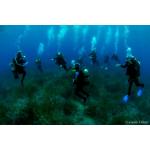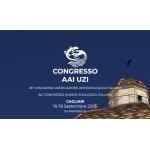1° Congresso Nazionale Congiunto SITE–UZI–SIB
Orchestra Sinfonica Carlo Coccia al Pavilion
Il Congresso congiunto si svolgerà presso la sede dell'Università di Milano Bicocca. 30 agosto - 2 settembre 2016
Biodiversity: concepts, new tools and future challenges
Nel primo congresso congiunto la Società Italiana di Ecologia, l'Unione Zoologica Italiana e la Società Italiana di Biogeografia si incontrano per presentare e condividere le ultime ricerche, i casi di studio, le attività di gestione e di educazione e per discutere le conoscenze scientifiche inerenti i nuovi strumenti di indagine e di predizione per lo studio della biosfera nei singoli aspetti: ecologici, zoologici e biogeografici.
Al fine di agevolare la partecipazione del maggior numero di congressisti si è deciso di scegliere fine agosto inizio settembre, periodo in cui le residenze dell’Università Bicocca sono completamente disponibili ad un prezzo estremamente vantaggioso.
Download Abstract degli interventi dei past-president e dell'attuale Presidente alla tavola rotonda UZI
Promemoria importanti e Premi UZI
>>Premi UZI "Giovani Ricercatori" (Download Regolamento)
L’Unione Zoologica Italiana bandisce un concorso per 4 premi di € 750,00 cadauno, di cui uno in collaborazione con il Comitato Scientifico per la Fauna d’Italia. La partecipazione è riservata a persone non strutturate di qualunque tipo (dottorandi di ricerca, assegnisti, borsisti, RTD) che, come autori singoli o tra i coautori, siano indicati come presentatori di un poster ed esibiscano un documento, rilasciato dal proprio Coordinatore/Tutor della ricerca, attestante che svolgano attualmente attività presso la struttura di afferenza.
il premio promosso dal Comitato Scientifico per la Fauna d’Italia sarà riservato a un contributo sostanziale ed originale nell’ambito della faunistica e della tassonomia di un gruppo di animali in Italia.
Il documento dovrà essere allegato all’abstract ed inviato in formato pdf all’indirizzo e-mail: bicocca2016@unimib.it
La domanda di partecipazione al concorso dovrà essere presentata contestualmente alla iscrizione al Congresso.
La presentazione dei poster selezionati avverrà giovedì 1 settembre 14:30-15:30
La premiazione poster si effettuerà venerdì 2 settembre 11:30-12:00 (dopo il coffee break)
Plenary Session e sessioni parallele organizzate dall'UZI
Plenary Session: Environmental DNA
giovedì 1 settembre, ore 9:30-10:15, Aula Magna, Edificio U6
Environmental DNA
giovedì 1 settembre, 11:00-13:00
Environmental DNA (a seguire dalla Plenary)
coordinatore Maurizio Casiraghi (maurizio.casiraghi@unimib.it) e Ettore Olmo (e.olmo@univpm.it)
Keynote Speaker: Prof. Pierre Taberlet, Laboratoire d'Ecologie Alpine (LECA), Univ. Grenoble
Environmental DNA (eDNA) is the genetic material obtained directly from environmental samples (soil, sediment, water, gut content etc.) without any obvious signs of biological source material. Thanks to efficient molecular techniques eDNA is easy to detect and the most important advantage is that through this method it is possible to detect species without actually seeing or catching them. eDNA signal can be very persistent (under specific conditions up to hundreds thousands of years).
Zoology and Ecology are naturally linked in the eDNA methods. Characterization of communities of organisms, ecological modelling, species invasions, pattern and dynamics of evolution are some of the keywords of this relatively new approach that has already deeply impacted the scientific community.
Interventi previsti: circa 10
Sessioni parallele
1) Rigenerazione e Differenziamento: modelli per ricerca di base ed applicazioni biotecnologiche
2) Ambienti profondi del Mediterraneo
martedì 30 agosto, 14:30-17:00
1) Rigenerazione e Differenziamento: modelli per ricerca di base ed applicazioni biotecnologiche
coordinatori Davide Malagoli (davide.malagoli@unimore.it) e Loriano Ballarin (loriano.ballarin@unipd.it)
Keynote speaker: Prof Francesco Cecconi (Dipartimento di Biologia, Università di Tor Vergata, Roma)
Growth, repair and aging are biological processes that occur in several tissues of plants and animals. The balance between cell proliferation and cell death is critical to maintain the correct functioning and spatial relationships of tissues; in addition, it is fundamental that tissue repair processes respect the original structure of the damaged components. In this context, regeneration and differentiation may appear as conflicting functions and frequently it has been observed that highly differentiated tissues lose the ability to regenerate, especially during adulthood. However, several examples exist of complex organisms that may regenerate whole parts of their body. These organisms are usually assumed as models for studying regeneration and cell differentiation, especially looking for potential insights in human development, tumorigenesis and aging.
Interventi previsti: 6-8
2) Ambienti profondi del Mediterraneo
coordinatori Giuseppe Corriero (g.corriero@biologia.uniba.it) e Giorgio Bavestrello (Giorgio.Bavestrello@unige.it)
Although the deep-sea represents the biggest marine habitat, the present knowledge is largely incomplete. Recent studies carried out by remote operating vehicles (ROV), have revealed that benthic biodiversity in this habitat reaches unsuspected levels, determining an increase in spatial heterogeneity due to the high concentration of structuring organisms. Examples of these organisms are the forests of sea fans and antipatharians as well as the assemblages of white corals and sponges. However, the deep-sea habitat is often subjected to the important economic activities such are the extraction of hydrocarbons and fishing by trawling gears. These activities may negatively impact the mainly undescribed, large and diverse communities, leading to their alterations or even destruction. In this light, conservation and management of the deep-sea habitats represent the compulsive topic aimed to preserve not only important reservoirs of biodiversity but also essential economic resources. This symposium aims collection of the information that will allow summarising of the present knowledge about biodiversity, structure and functioning of the ecosystems, and the conservation strategies aimed to face the possible alterations due to the human activities.
Interventi previsti: 8-9
3) Eco Evo Devo
mercoledì 31 agosto, 11:00-13:00
3) Eco Evo Devo
coordinatore Fiorenza De Bernardi (fiorenza.debernardi@unimi.it)
Ecological evolutionary developmental biology tries to organize into evolutionary theory the interactions between genes and development of an organism with the environment. This means that the environment is not merely a selective agent, but it also shapes the production of phenotypes. Developmental plasticity is the ability of larval or embryonic organisms to react to environmental input with a change in form, physiology or behaviour. It can facilitate niche construction, the process whereby an organism in turn can alter its environment.
Interventi previsti: 6-8.
4) Ritmi di attività e orologi biologici in animali e piante
5) Ambiente sotteraneo
mercoledì 31 agosto, 14:30-18:00
4) Ritmi di attività e orologi biologici in animali e piante
coordinatori Alberto Ugolini (alberto.ugolini@unifi.it) e Cristina Giacoma (cristina.giacoma@unito.it)
Keynote speaker: Prof. Rodolfo Costa (Dip. Biologia, Univ. Padova)
La cronobiologia è una branca della biologia altamente interdisciplinare che studia fenomeni ciclici negli organismi. Sebbene indagini di tipo cronobiologico risalgano al XVIII secolo, soltanto abbastanza recentemente sono stati effettuati consistenti passi in avanti per la comprensione del funzionamento dei meccanismi cronometrici che sottendono alla regolazione dell’attività ritmica, avvalendosi del contributo di diverse discipline come anatomia comparata, ecologia, fisiologia, genetica, biologia molecolare e, non ultima, etologia. Il simposio su “Attività ritmica in animali e piante” ha lo scopo di offrire una opportunità di incontro e discussione a ricercatori appartenenti ad ambienti scientifici diversi.
Interventi previsti: 7-8.
5) Ambiente sotteraneo
coordinatori Marzio Zapparoli (zapparol@unitus.it) e Diana Galassi (diana.galassi@univaq.it)
Keynote speaker: Dr. Leonardo Latella, Museo Civico di Storia Naturale di Verona
The underground environment includes a multitude of terrestrial and aquatic habitat types. Among them, caves are the most popular only because directly accessible to man. Here, the two components may or may not coexist and boundaries between them are often difficult to distinguish. However, there are many other types of underground habitat types, less known only because hardly accessible, such as the Groundwater Dependent Ecosystems (GDEs), into permanent or intermittent contact with surface waters, and the Superficial Subterranean Habitats (MSS), adjacent to soil (endogean environment). The most compelling features of the “underworld” are the darkness syndrome and the absence of primary productivity, if we exclude chemoautotrophy, which limit the complexity of the food chains. The underground environment home a specialized, endemic-rich fauna, often with spot distribution, organized in more or less complex communities, whose biological and functional diversity depends on diverse historical and ecological factors. The subterranean species are often phylogenetic or distributional relicts, the only survivors of ancient groups disappeared from the Earth ‘surface, or ecological indicators, because very sensitive to environmental changes.
Interventi previsti: 6-8.
Environmental DNA (a seguire dalla Plenary)
giovedì 1 settembre, 11:00-13:00
Environmental DNA (a seguire dalla Plenary)
coordinatore Maurizio Casiraghi (maurizio.casiraghi@unimib.it) e Ettore Olmo (e.olmo@univpm.it)
Keynote Speaker: Prof. Pierre Taberlet, Laboratoire d'Ecologie Alpine (LECA), Univ. Grenoble
Environmental DNA (eDNA) is the genetic material obtained directly from environmental samples (soil, sediment, water, gut content etc.) without any obvious signs of biological source material. Thanks to efficient molecular techniques eDNA is easy to detect and the most important advantage is that through this method it is possible to detect species without actually seeing or catching them. eDNA signal can be very persistent (under specific conditions up to hundreds thousands of years).
Zoology and Ecology are naturally linked in the eDNA methods. Characterization of communities of organisms, ecological modelling, species invasions, pattern and dynamics of evolution are some of the keywords of this relatively new approach that has already deeply impacted the scientific community.
Interventi previsti: circa 10
Tavola rotonda su "Conoscere il passato per un migliore futuro"
giovedì 1 settembre, 14:30-15:30
Conoscere il passato per un migliore futuro
Coordinatore: Pierangelo Luporini
Interventi: Giulio Lanzavecchia, Ernesto Capanna, Romano Dallai, Salvatore Fasulo, Emilio Balletto, Ettore Olmo, Elvira De Matthaeis
La nostra Unione Zoologica fronteggia tempi difficili, forse come non mai in passato. Sintomatico è il declino nel numero dei Soci e nella partecipazione ai congressi. Un impegno collettivo per identificarne le cause è la strada maestra per delineare prospettive migliori della nostra Società.
Questa Tavola Rotonda è stata ideata dal Direttivo e dagli Organizzatori del 77° Congresso UZI come un primo passo su questa strada. Rivivendo con Giulio Lanzavecchia, Ernesto Capanna, Romano Dallai, Salvatore Fasulo, Emilio Balletto, Ettore Olmo e Elvira De Matthaeis esperienze e fatti di quadrienni di Presidenza passati e del quadriennio in corso, la Tavola Rotonda si prefigge di mettere a fuoco stimoli e suggerimenti che possano essere di riferimento per rinnovare e promuovere un più entusiastico e partecipato interesse per la nostra Unione Zoologica.
Assembela
giovedì 1 settembre, 16:30-18:00
Assemblea
Concorso UZI giovani ricercatori
venerdì 2 settembre
Presentazione poster: venerdì 2 settembre 9:30-10:30
Premiazione poster: venerdì 2 settembre 11:30-12:30







